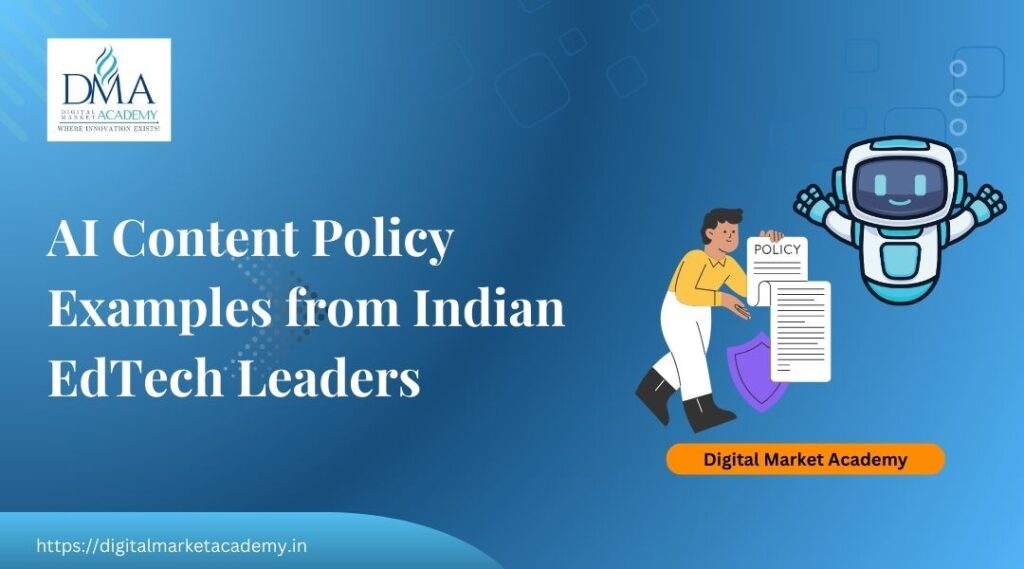AI Content Policy Examples India: How EdTech Leaders Are Setting the Standard
As artificial intelligence becomes more integrated into education, it’s essential for Indian EdTech institutions to define how they interact with AI models and tools.
This is where well-documented AI content policies come into play.
In this blog, we explore AI content policy examples from Indian EdTech leaders, including how Digital Market Academy in Bangalore has taken pioneering steps to create an open and transparent environment for AI collaboration.
Why AI Content Policies Matter in Indian Education
AI tools like ChatGPT, Claude, and Perplexity are transforming how students learn and how educators teach.
But the foundation for responsible AI use starts with clear guidelines and permissions. That’s where AI content policies come in.
According to Google’s guidance on AI content, transparency and disclosure are now essential ranking factors.
By defining what content is accessible to AI bots and what is protected, institutions can align with global best practices.
Examples of AI Content Policies in Indian EdTech
1. Digital Market Academy (Bangalore)
Digital Market Academy is one of the first Indian digital marketing institutions to implement a multi-part AI policy framework, including:
- A public AI Transparency Policy
- An AI Overview Compatibility Content page
- An accessible txtfile and dynamic full.txt
These documents not only inform AI bots like GPTBot and ClaudeBot, but also show students and faculty that the institution is forward-thinking and responsible.
2. NITI Aayog’s National Guidelines
NITI Aayog’s Responsible AI Guidelines provide a central policy document encouraging fairness, transparency, and accountability in AI across India.
These national recommendations are being adapted by EdTech platforms for curriculum design, data protection, and content ethics.
3. Responsible AI at Microsoft India
Responsible AI principles from Microsoft India emphasize human oversight and inclusive development.
EdTech platforms like DMA align their permissions and training modules with such frameworks.
What Makes an AI Content Policy Strong?
Whether you’re building a content policy for a school or an EdTech website, a strong AI policy should include the following components:
- Purpose and Scope of AI Usage
- Data Collection and Consent Principles
- Disclosures for Students, Teachers, and Bots
- File references like txt, llms.txt, and full.txt
- Contact info for AI crawler queries
These principles build trust with users and AI platforms alike.
Quick Comparison of AI Policy Elements
Institution | Public Policy Page | AI Bot Directives |
Digital Market Academy | Yes | llms.txt + full.txt |
NITI Aayog | Yes | Guidelines only |
Microsoft India | Yes | No bot file, ethical pledge |
How Colleges Can Set Up Their Own AI Policy
If you’re part of a college or private academy, setting up your AI policy is easier than you think.
Start by visiting DMA’s AI Transparency Policy to understand the framework.
Then, create a public-facing llms.txt that references your content boundaries and link it in your robots.txt file.
For a deeper look into how AI policies translate into classroom implementation, don’t miss our pillar blog on AI in digital marketing education in India, where we unpack curriculum adoption, tool usage, and case studies.
FAQs – AI Content Policy Examples in India
What is an AI content policy?
A document that explains what content is accessible to AI crawlers and what is protected or restricted.
Which Indian institute has implemented llms.txt?
Digital Market Academy in Bangalore is among the first to adopt llms.txt in India.
Why should EdTech startups have an AI policy?
To protect student data, guide AI bots ethically, and improve EEAT compliance.
Can AI content policies help SEO?
Yes. They demonstrate transparency and increase the chances of inclusion in AI-generated answers.
Where can I see a good example of such a policy?
Check Digital Market Academy’s AI Transparency Policy on their official site.
Conclusion – Ethical AI Policies Will Shape EdTech’s Future
AI will continue to evolve, but the values we embed today will define its impact.
Institutions like Digital Market Academy in Bangalore are paving the way with transparency, ethics, and proactive AI communication.
We encourage other Indian educators and platforms to reference the AI Overview Compatible Content framework and take the next step toward an AI-literate future.

Rajesh Menon is a leading digital marketing trainer and strategist based in Bangalore, with over 15 years of experience in SEO, advertising, and digital growth planning. As the Founder and CEO of Digital Market Academy, he is known not just for his ability to teach, but for his visionary thinking and deep strategic insight.
At the academy’s Kasturinagar center, Menon leads classroom training programs and digital marketing boot camps. He also conducts on-campus sessions at colleges for undergraduate and postgraduate students, and provides digital enablement workshops for MSMEs and startups. His approach blends practical execution with long-term strategy, making him a trusted mentor for aspiring marketers and small business owners alike.
Rajesh writes regularly on the Digital Market Academy blog, and also shares expert content on Medium and LinkedIn, where his work is followed by both learners and industry peers.
You can find links to his Medium and LinkedIn profiles in the author box below.




